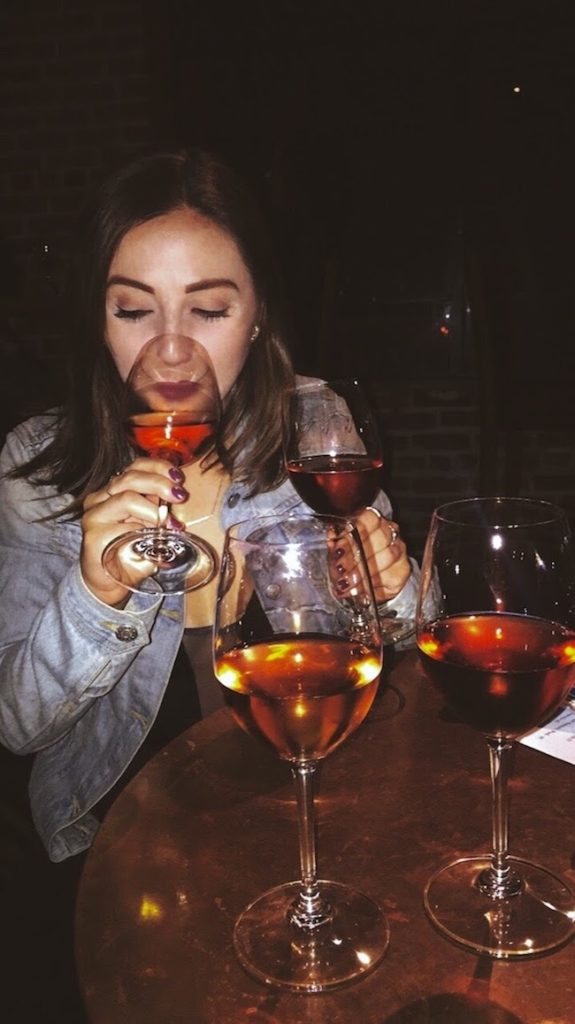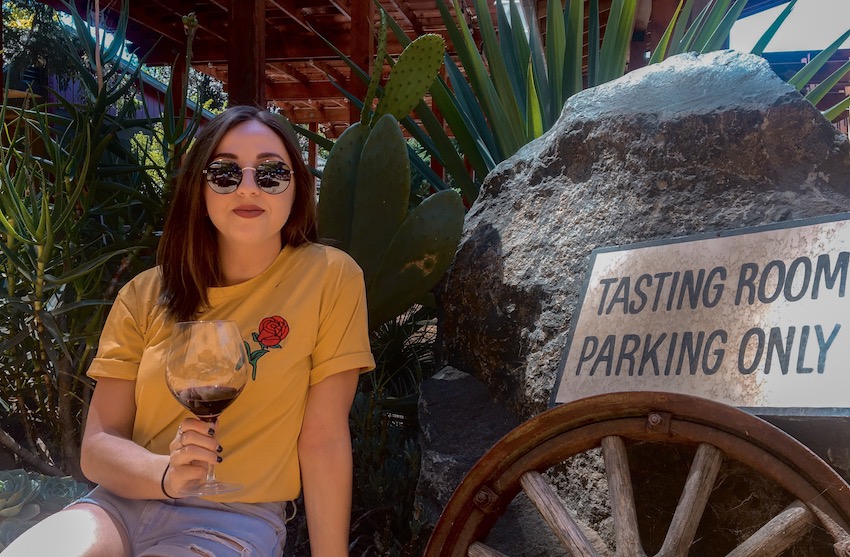“How do you like the wine?”
“It’s umm…good. Definitely a red.”
Does this conversation sound familiar? It certainly did to me for the majority of my legal drinking years.
However today, as a proud frequent wine taster, I’d be remiss if I squandered an opportunity to drop some knowledge on my fellow aspiring wine snobs.

In college, I wanted so badly to like wine. I always envisioned myself as someday being the cool girl who drank black coffee and sipped on red wine. (Dream big, kids!) But the reality was, Moscatos and Rieslings were what were on the menu.
Well folks, I’m happy to report, as I guzzle my morning black coffee, that this girl has graduated to the big leagues and now I’m going to share my top tips with you!
My Top 5 Wine Tasting Topics

VARIETY VS. VARIETAL
One is a grape, one describes a wine.
Variety(n) is the type of grape used to make the wine. There are Cabernet Sauvignon grapes, Chardonnay grapes, Zinfandel grapes, etc.
Varietal(adj) describes a wine made from a single or dominant grape variety. It needs to have at least 75% of a certain variety of grape.
“Is it important to know?”
Most def. Not all wines were created equal. Some people love white wine, but don’t like Riesling. Some people only like lighter reds like Pinot Noir. Learn their names so you can start narrowing down what you like.
“But how do I sound smart saying it?”
When you’re ordering at a bar and the bartender says they have red and white wine, ask, “what are your varietals of reds/whites?” After picking his/her jaw up from the floor from pure respect and awe, you will hear a list of names such as Sauvignon Blanc, Chardonnay, Merlot, and Cabernet.


FLAVOR PROFILE
In a nutshell, what do you taste?
This one’s simple. Every wine has its own flavors and flavor profile. Is it fruity? Earthy? Florally? Getting these words down is 90% of the battle.
“Is it important to know?”
Put it this way: how much would you hate if you kept eating food with cilantro, and didn’t like it, but couldn’t figure out why? Being able to describe the flavors you do and don’t like will be enormously helpful in choosing wines. (By the way, Team Cilantro all the way.)
“But how do I sound smart saying it?”
Once you learn what you like, you can better ask for recommendations. Ex: I’m not a big fan of Chardonnays with oak or creamy flavors. So I might ask, “Is the Chardonnay creamy and oaky or is it citrusy?”
Extra help: study up on this red or this white flavor profile chart. It’s a sure fire way to better understand the difference in flavors between wine varieties.

BODY
Bodies and wine? Couldn’t resist a Silence of the Lambs reference here. But a wine’s body actually refers to density and alcohol level.
Wines range from light to medium to full-bodied. Typically, more full-bodied wines are the most dense and contain the most alcohol.
One way to tell? Legs. You know those streaks you see on your wine glass after you take a sip? Those are the legs and they exist in wines that have a higher alcohol content.
“Is it important to know?”
Kind of. When you’re drinking a wine you’ve never tried before and don’t have the bottle handy, it’s a good way to possibly indicate the alcohol levels AKA how much you can get your drank on.
“But how do I sound smart saying it?”
You can determine the type of body you’re drinking by how it feels in your mouth. Try comparing the sensation to drinking milk: Does it feel heavy like cream (full-bodied) or thin like skim milk (light-bodied)?

TANNINS
That stuff that makes your mouth pucker.
Anything other than the actual juice of the grape is what contributes to tannins. Ex: the wood of the wine barrel, grape skins, seeds, stems, etc.
Basically, if the wine dries out your mouth, it is tannic.
Think of it like tea that is brewed too long. If you get a dry feeling in your mouth after a sip of wine, it is likely because of tannins.
“Is it important to know?”
This one isn’t super important, but can be a bonus thing to say to impress a crowd. Unless you’re with Marshall Eriksen, he’ll hate that.
“But how do I sound smart saying it?”
Some phrases you can say are the wine is “tannic”, “has strong tannins”, or “has weak tannins”. But head’s up: tannins are most often used to describe red wine. The juices are soaked in the seeds and stems longer than for a white so they can get a nice red color and therefore, more tannins.


“LET THE WINE BREATHE”
AKA let some oxygen into that bad boy.
Wine is constantly evolving! Once you open a bottle of wine, the “breathing” begins. This is why people swirl their wine and have wine aerators or wine decanters. Exposing wine to more oxygen releases aromas and can soften flavors.
Young red wines with high tannins usually benefit the most from this because the tannins soften and the wine becomes less harsh.
“Is it important to know?”
Not crucial, but it helps! Most red and some white wines will improve within the first half hour of opening the bottle, and who doesn’t want better tasting wine?
“But how do I sound smart saying it?”
This one is more about actions than speaking. When you get a glass of red wine, swirl it. You may have heard of the 5 S’s: See, Swirl, Sniff, Sip, and Spit. Once you swirl the wine, the aromas should be a little easier to pick up on. Or if you’re having people over, open the wine at least 30 minutes before you want to drink it. Sidenote, I’ve never seen someone spit. Sounds fake, but okay.
Okay great, you got all that?
I know it’s a lot, but if you take away one thing, here is my favorite thing I was ever told at a wine tasting: you’re never wrong.
When it comes to wine, you taste what you taste and you like what you like. Maybe you think the Merlot tastes like blackberries and vanilla, but your friend might not get any of that. That’s okay! Even the top sommeliers argue over these little details.
Plus, if you’re anything like this girl, wine is wine. It’s meant to be enjoyed, so enjoy it!
Salud!

Thirsty For More Wine Knowledge?
Christina’s Favorites:
- Instagram: @winefolly
- Blog: Between The Vines (Shoutout to my girl, Miriah!)
- Book: Wine Folly: The Essential Guide to Wine
- Movie: Somm


